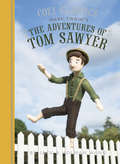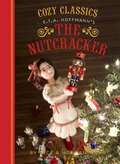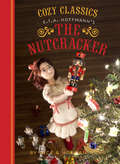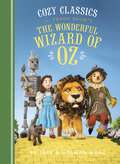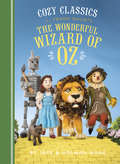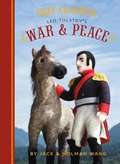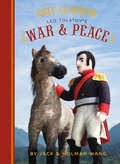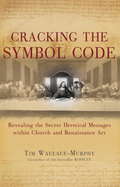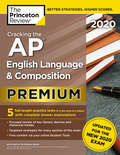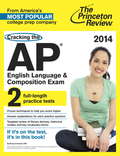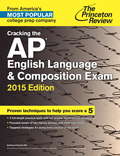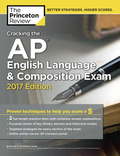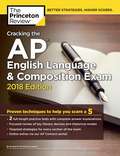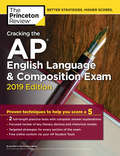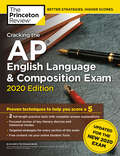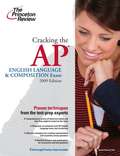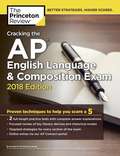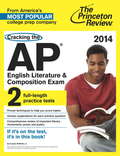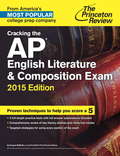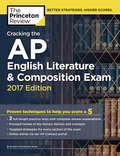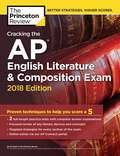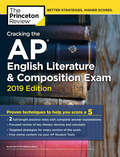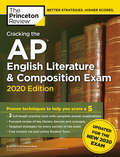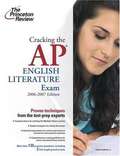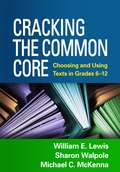- Table View
- List View
Cozy Classics: The Adventures of Tom Sawyer (Cozy Classics #8)
by Holman Wang Jack WangCuddle up with a classic! In twelve needle-felted scenes and twelve child-friendly words, each book in this ingenious series captures the essence of a literary masterpiece. Simple words and a beloved story make this ebook the perfect vehicle for early learning with an erudite twist. Budding bookworms will delight in this clever retelling of the classics made just for them!In Mark Twain's The Adventures of Tom Sawyer, young Tom has a first kiss, makes camp in the woods, and discovers the secrets of a mysterious cave. It's a first words primer for your literary little one!The Cozy Classics series is the brainchild of two brothers, both dads, who were thinking of ways to teach words to their very young children. They hit upon the classics as the basis for their infant primers, and the rest, as they say, is history. From Moby Dick to Pride and Prejudice, here are The Great Books of Western Literature for toddlers and their parents in ebook form—a little bit serious, a little bit ironic, entirely funny and clever, and always a welcome read.
Cozy Classics: The Nutcracker
by Holman Wang Jack WangCuddle up with a classic! In twelve needle-felted scenes and twelve child-friendly words, each book in this ingenious series captures the essence of a literary masterpiece. Simple words, sturdy pages, and a beloved story make these books the perfect vehicle for early learning with an erudite twist. Budding bookworms will delight in this clever retelling of the classics made just for them!In E. T. A. Hoffmann's The Nutcracker, marvel at Maria's favorite gift, cheer as she defeats the Mouse King, and journey to the magical Land of Sweets. It's a festive first words primer for your literary little one!The Cozy Classics series is the brainchild of two brothers, both dads, who were thinking of ways to teach words to their very young children. They hit upon the classics as the basis for their infant primers, and the rest, as they say, is history. From Moby Dick to Pride and Prejudice, here are The Great Books of Western Literature for toddlers and their parents in ebook form--a little bit serious, a little bit ironic, and entirely funny and clever.
Cozy Classics: The Nutcracker (Cozy Classics)
by Holman Wang Jack WangCuddle up with a classic! In twelve needle-felted scenes and twelve child-friendly words, each book in this ingenious series captures the essence of a literary masterpiece. Simple words, sturdy pages, and a beloved story make these books the perfect vehicle for early learning with an erudite twist. Budding bookworms will delight in this clever retelling of the classics made just for them!In E. T. A. Hoffmann's The Nutcracker, marvel at Maria's favorite gift, cheer as she defeats the Mouse King, and journey to the magical Land of Sweets. It's a festive first words primer for your literary little one!The Cozy Classics series is the brainchild of two brothers, both dads, who were thinking of ways to teach words to their very young children. They hit upon the classics as the basis for their infant primers, and the rest, as they say, is history. From Moby Dick to Pride and Prejudice, here are The Great Books of Western Literature for toddlers and their parents in ebook form—a little bit serious, a little bit ironic, and entirely funny and clever. Plus, this is the fixed format version, which looks almost identical to the print edition.
Cozy Classics: The Wonderful Wizard of Oz
by Holman Wang Jack WangCuddle up with a classic! In twelve needle-felted scenes and twelve child-friendly words, each book in this ingenious series captures the essence of a literary masterpiece. Simple words, sturdy pages, and a beloved story make these books the perfect vehicle for early learning with an erudite twist. Budding bookworms will delight in this clever retelling of the classics made just for them! In L. Frank Baum'sThe Wonderful Wizard of Oz, astorm transports Dorothy to the magical Land of Oz. Can she defeat the WickedWitch and find her wayhome? It's a first words primer for your literary little one! The Cozy Classics series is the brainchild of two brothers, both dads, who were thinking of ways to teach words to their very young children. They hit upon the classics as the basis for their infant primers, and the rest, as they say, is history. From Moby Dick to Pride and Prejudice, here are The Great Books of Western Literature for toddlers and their parents in board book form--a little bit serious, a little bit ironic, entirely funny and clever, and always a welcome gift.
Cozy Classics: The Wonderful Wizard of Oz (Cozy Classics)
by Holman Wang Jack WangCuddle up with a classic! In twelve needle-felted scenes and twelve child-friendly words, each book in this ingenious series captures the essence of a literary masterpiece. Simple words and a beloved story make this ebook the perfect vehicle for early learning with an erudite twist. Budding bookworms will delight in this clever retelling of the classics made just for them!In L. Frank Baum's The Wonderful Wizard of Oz, a storm transports Dorothy to the magical Land of Oz. Can she defeat the Wicked Witch and find her way home? It's a first words primer for your literary little one!The Cozy Classics series is the brainchild of two brothers, both dads, who were thinking of ways to teach words to their very young children. They hit upon the classics as the basis for their infant primers, and the rest, as they say, is history. From Moby Dick to Pride and Prejudice, here are The Great Books of Western Literature for toddlers and their parents in ebook form—a little bit serious, a little bit ironic, entirely funny and clever, and always a welcome read.
Cozy Classics: War & Peace
by Holman Wang Jack WangCuddle up with a classic! In twelve needle-felted scenes and twelve child-friendly words, each book in this ingenious series captures the essence of a literary masterpiece. Simple words, sturdy pages, and a beloved story make these books the perfect vehicle for early learning with an erudite twist. Budding bookworms will delight in this clever retelling of the classics made just for them!Leo Tolstoy's War and Peace features a dashing soldier, many difficult goodbyes, and the fleeting promise of true love. It's a first words primer for your literary little one!The Cozy Classics series is the brainchild of two brothers, both dads, who were thinking of ways to teach words to their very young children. They hit upon the classics as the basis for their infant primers, and the rest, as they say, is history. From Moby Dick to Pride and Prejudice, here are The Great Books of Western Literature for toddlers and their parents in board book form--a little bit serious, a little bit ironic, entirely funny and clever, and always welcome.
Cozy Classics: War & Peace (Cozy Classics)
by Holman Wang Jack WangCuddle up with a classic! In twelve needle-felted scenes and twelve child-friendly words, each book in this ingenious series captures the essence of a literary masterpiece. Simple words, sturdy pages, and a beloved story make these books the perfect vehicle for early learning with an erudite twist. Budding bookworms will delight in this clever retelling of the classics made just for them!Leo Tolstoy's War and Peace features a dashing soldier, many difficult goodbyes, and the fleeting promise of true love. It's a first words primer for your literary little one!The Cozy Classics series is the brainchild of two brothers, both dads, who were thinking of ways to teach words to their very young children. They hit upon the classics as the basis for their infant primers, and the rest, as they say, is history. From Moby Dick to Pride and Prejudice, here are The Great Books of Western Literature for toddlers and their parents in board book form—a little bit serious, a little bit ironic, entirely funny and clever, and always welcome.
Cracking The Symbol Code
by Tim Wallace-MurphyA heretic in medieval times was anyone who dissented from the established Church's view, and to be branded a heretic invited torture and execution. This title presents an alternative Christian story told by those who were outlawed by the orthodox Church, and includes secret codes and symbolism.
Cracking the AP English Language & Composition Exam 2020, Premium Edition: 5 Practice Tests + Complete Content Review + Proven Prep for the NEW 2020 Exam (College Test Preparation)
by The Princeton ReviewPREMIUM PREP FOR A PERFECT 5! Ace the 2020 AP English Language & Composition Exam with this Premium version of the Princeton Review's comprehensive study guide—including 5 full-length practice tests with complete explanations, thorough content reviews, targeted strategies for every section of the exam, and access to online extras.Techniques That Actually Work.• Tried-and-true strategies to help you avoid traps and beat the test• Tips for pacing yourself and guessing logically• Essential tactics to help you work smarter, not harderEverything You Need to Know to Help Achieve a High Score.• Comprehensive review of the synthesis, rhetorical analysis,and argumentative essays• Engaging coverage on word use and rhetorical modes to help you improve your writing progress• Up-to-date information on the 2020 AP® English Language & Composition Exam• Access to study plans, a handy list of key terms, helpful pre-college information, and more via your online Student ToolsPremium Practice for AP Excellence.• 3 full-length practice tests in the book with detailed answer explanations• 2 full-length practice tests online with detailed answer explanations• Pacing drills to help you maximize points on the multiple choice section• Sample student essays scored with thorough assessments from our test expertsWritten by Princeton Review experts who know their way around an essay, Cracking the AP English Language & Composition Exam, Premium Edition arms you with the tools you need for confidence on test day.
Cracking the AP English Language & Composition Exam, 2013 Edition
by Princeton ReviewIf you need to know it, it's in this book! The eBook edition of Cracking the AP English Language & Composition Exam has been optimized for e-reader viewing with cross-linked questions, answers, and explanations. The 2013 edition includes: * 2 full-length practice tests with detailed explanations * A comprehensive "Hit Parade" of important vocabulary words * Detailed coverage of all essay types--rhetorical analysis, argumentative, and synthesis * Tips on how to craft a winning synthesis essay * Useful techniques for cracking the multiple-choice section * Updated strategies that reflect the AP test scoring change
Cracking the AP English Language & Composition Exam, 2015 Edition
by Princeton ReviewEVERYTHING YOU NEED TO SCORE A PERFECT 5. Equip yourself to ace the AP English Language & Composition Exam with The Princeton Review's comprehensive study guide--including thorough content reviews, targeted strategies for every question type, and 2 full-length practice tests with complete answer explanations. We don't have to tell you how tough it can be to prepare for the AP English Language & Composition Exam--or how important a stellar score on the test can be for your college applications. Written by Princeton Review experts who know their way around an essay, Cracking the AP English Language and Composition Exam will give you:Techniques That Actually Work.* Tried-and-true strategies to avoid traps and beat the test* Tips for pacing yourself and guessing logically* Essential tactics to help you work smarter, not harderEverything You Need to Know for a High Score.* Detailed coverage of the synthesis, rhetorical analysis, and argumentative essays* Engaging activities to help you critically assess your progress* Up-to-date information on the 2015 examPractice Your Way to Perfection.* 2 full-length practice tests with detailed answer explanations and scoring worksheets* Pacing drills to help you maximize points* Sample student essays scored at different levels
Cracking the AP English Language & Composition Exam, 2017 Edition: Proven Techniques to Help You Score a 5
by Princeton ReviewEVERYTHING YOU NEED TO HELP SCORE A PERFECT 5. Equip yourself to ace the AP English Language & Composition Exam with The Princeton Review's comprehensive study guide--including 2 full-length practice tests, thorough content reviews, access to our AP Connect online portal, and targeted strategies for every section of the exam.This eBook edition has been optimized for on-screen viewing with cross-linked questions, answers, and explanations.We don't have to tell you how tough it can be to prepare for the AP English Language & Composition Exam--or how important a stellar score on the test can be for your college applications. Written by Princeton Review experts who know their way around an essay, Cracking the AP English Language & Composition Exam arms you with:Techniques That Actually Work.* Tried-and-true strategies to help you avoid traps and beat the test* Tips for pacing yourself and guessing logically* Essential tactics to help you work smarter, not harderEverything You Need to Know to Help Achieve a High Score.* Focused review of key literary devices and rhetorical modes* Thorough coverage of the synthesis, rhetorical analysis, and argumentative essays* Access to AP Connect, our online portal for helpful pre-college information and exam updatesPractice That Takes You to Excellence.* 2 full-length practice tests with detailed answer explanations and scoring worksheets* Pacing drills to help you maximize points* Sample student essays scored at different levels<P><P> Advisory: Bookshare has learned that this book offers only partial accessibility. We have kept it in the collection because it is useful for some of our members. To explore further access options with us, please contact us through the Book Quality link on the right sidebar. Benetech is actively working on projects to improve accessibility issues such as these.
Cracking the AP English Language & Composition Exam, 2018 Edition: Proven Techniques to Help You Score a 5
by Princeton ReviewEVERYTHING YOU NEED TO HELP SCORE A PERFECT 5. Equip yourself to ace the AP English Language & Composition Exam with this comprehensive study guide—including 2 full-length practice tests, thorough content reviews, access to our AP Connect online portal, and targeted strategies for every section of the exam.This eBook edition has been optimized for on-screen reading with cross-linked questions, answers, and explanations. Written by Princeton Review experts who know their way around an essay, Cracking the AP English Language & Composition Exam arms you with:Techniques That Actually Work.• Tried-and-true strategies to help you avoid traps and beat the test• Tips for pacing yourself and guessing logically• Essential tactics to help you work smarter, not harderEverything You Need to Know to Help Achieve a High Score.• Thorough coverage of the synthesis, rhetorical analysis, and argument essays• Focused review of key literary devices and rhetorical modes• Engaging activities to help you critically assess your progress• Access to AP Connect, our online portal for helpful pre-college information and exam updatesPractice That Takes You to Excellence.• 2 full-length practice tests with detailed answer explanations and scoring worksheets• Pacing drills to help you maximize points• Sample student essays scored at different levels
Cracking the AP English Language & Composition Exam, 2019 Edition: Practice Tests & Proven Techniques to Help You Score a 5 (College Test Preparation)
by Princeton ReviewEVERYTHING YOU NEED TO HELP SCORE A PERFECT 5. Ace the AP English Language & Composition Exam with this comprehensive study guide—including 2 full-length practice tests with complete explanations, thorough content reviews, targeted strategies for every section of the exam, and access to online extras.Everything You Need to Know to Help Achieve a High Score.• Comprehensive review of the synthesis, rhetorical analysis, and argumentative essays• Focused review of key literary devices and rhetorical modes• Engaging coverage ob word use and rhetorical modes to help you improve your writing• Up-to-date information to prepare you for the 2019 AP English Language & Composition Exam• Access to an online study guide, a handy list of key terms, helpful pre-college information, and morePractice That Takes You to Excellence.• 2 full-length practice tests with detailed answer explanations• Pacing drills to help you maximize points on the multiple-choice section• Sample student essays scored with thorough assessments from our test expertsTechniques That Actually Work.• Tried-and-true strategies to help you avoid traps and beat the test• Tips for pacing yourself and guessing logically• Essential tactics to help you work smarter, not harderWritten by Princeton Review experts who know their way around an essay, Cracking the AP English Language & Composition Exam arms you with the tools you need for confidence on test day.
Cracking the AP English Language & Composition Exam, 2020 Edition: Practice Tests & Prep for the NEW 2020 Exam (College Test Preparation)
by The Princeton ReviewEVERYTHING YOU NEED TO HELP SCORE A PERFECT 5. Ace the 2020 AP English Language & Composition Exam with this comprehensive study guide—including 2 full-length practice tests with complete explanations, thorough content reviews, targeted strategies for every section of the exam, and access to online extras.Techniques That Actually Work.• Tried-and-true strategies to help you avoid traps and beat the test• Tips for pacing yourself and guessing logically• Essential tactics to help you work smarter, not harderEverything You Need to Know to Help Achieve a High Score.• Comprehensive review of the synthesis, rhetorical analysis, and argumentative essays• Engaging coverage on word use and rhetorical modes to help you improve your writing• Up-to-date information on the 2020 AP® English Language & Composition Exam• Access to study plans, a handy list of key terms, helpful pre-college information, and more via your online Student ToolsPractice Your Way to Excellence.• 2 full-length practice tests with detailed answer explanations• Pacing drills to help you maximize points on the multiple choice section• Sample student essays scored with thorough assessments from our test expertsWritten by Princeton Review experts who know their way around an essay, Cracking the AP English Language & Composition Exam arms you with the tools you need for confidence on test day.
Cracking the AP English Language and Composition Exam (2009 Edition)
by Richard HartzellScoring high on the AP English Language and Composition Exam is very different from earning straight A's in school. We don't try to teach you everything there is to know about English language -- only the strategies and information you'll need to get your highest score. In Cracking the AP English Language and Composition Exam, we'll teach you how to<P>· Use our preparation strategies and test-taking techniques to raise your score<P>· Focus only on the rhetorical modes and patterns of exposition that are likely to be covered on the test<P>· Test your knowledge with review questions for each topic covered.<P>This book includes 2 full-length practice AP English Language and Composition tests. All of our practice questions are just like those you'll see on the actual exam, and we explain how to answer every question. Cracking the AP English Language and Composition Exam has been fully updated for the 2009 test.
Cracking the AP English Language and Composition Exam, 2018 Edition
by The Staff of the Princeton ReviewEVERYTHING YOU NEED TO HELP SCORE A PERFECT 5. Ace the AP English Language & Composition Exam with this comprehensive study guide—including 2 full-length practice tests, thorough content reviews, access to our AP Connect online portal, and targeted strategies for every section of the exam. Written by Princeton Review experts who know their way around an essay, Cracking the AP English Language & Composition Exam arms you with: Everything You Need to Know to Help Achieve a High Score. • Thorough coverage of the synthesis, rhetorical analysis, and argument essays • Focused review of key literary devices and rhetorical modes • Engaging activities to help you critically assess your progress • Access to AP Connect, our online portal for helpful pre-college information and exam updates. Practice That Takes You to Excellence. • 2 full-length practice tests with detailed answer explanations and scoring worksheets • Pacing drills to help you maximize points • Sample student essays scored at different levels. Techniques That Actually Work. • Tried-and-true strategies to help you avoid traps and beat the test • Tips for pacing yourself and guessing logically • Essential tactics to help you work smarter, not harder.
Cracking the AP English Literature & Composition Exam, 2013 Edition
by Princeton ReviewIf you need to know it, it's in this book! This eBook edition of Cracking the AP English Language & Composition Exam has been optimized for on-screen viewing with cross-linked questions, answers, and explanations. The 2013 edition includes: * 2 full-length practice tests with detailed explanations * In-depth, engaging review of important literary movements * Comprehensive glossary of key AP English Literature terms * Practical, targeted advice for writing high-scoring essays * Useful techniques for cracking the multiple-choice section * Updated strategies that reflect the AP test scoring change
Cracking the AP English Literature & Composition Exam, 2015 Edition
by Princeton ReviewEVERYTHING YOU NEED TO SCORE A PERFECT 5. Equip yourself to ace the AP English Literature & Composition Exam with The Princeton Review's comprehensive study guide--including thorough content reviews, targeted strategies for every question type, and 2 full-length practice tests with complete answer explanations.We don't have to tell you how tough the AP English Lit exam is--or how important a stellar score on it can be to your chances of getting into a top college of your choice. Written by Princeton Review experts who know their way around stats, Cracking the AP English Literature & Composition Exam will give you:Everything You Need to Know for a High Score.* Comprehensive content review for all test topics* Up-to-date information on the 2015 AP English Literature & Composition Exam* Engaging activities to help you critically assess your progressPractice Your Way to Perfection.* 2 full-length practice tests with detailed answer explanations* Practice drills in each content review chapter* Sample prose, poetry, and open essays to help you plan and organize your ownwriting effectively on the day of the examTechniques That Actually Work.* Tried-and-true strategies to avoid traps and beat the test* Tips for pacing yourself and guessing logically* Essential tactics to help you work smarter, not harder
Cracking the AP English Literature & Composition Exam, 2017 Edition: Proven Techniques to Help You Score a 5
by Princeton ReviewEVERYTHING YOU NEED TO HELP SCORE A PERFECT 5. Equip yourself to ace the AP English Literature Exam with The Princeton Review's comprehensive study guide--including 2 full-length practice tests, thorough content reviews, access to our AP Connect online portal, and targeted strategies for every section of the exam.This eBook edition is optimized for on-screen viewing with cross-linked questions, answers, and explanations.We don't have to tell you how tough the AP English Lit Exam is--or how important a stellar score on it can be to your chances of getting into a top college of your choice. Written by Princeton Review experts who know their way around an essay, Cracking the AP English Literature & Composition Exam will give you:Techniques That Actually Work.* Tried-and-true strategies to help you avoid traps and beat the test* Tips for pacing yourself and guessing logically* Essential tactics to help you work smarter, not harderEverything You Need to Know to Help Achieve a High Score.* Comprehensive review of key literary devices and concepts* Up-to-date information on the 2017 AP English Literature & Composition Exam* Engaging activities to help you critically assess your progress* Access to AP Connect, our online portal for helpful pre-college information and exam updatesPractice Your Way to Excellence.* 2 full-length practice tests with detailed answer explanations and scoring worksheets* Practice drills for poetry and prose passages* Sample essays with tips to help you effectively plan and organize your own writing on the day of the exam
Cracking the AP English Literature & Composition Exam, 2018 Edition: Proven Techniques to Help You Score a 5
by Princeton ReviewEVERYTHING YOU NEED TO HELP SCORE A PERFECT 5. Equip yourself to ace the AP English Literature Exam with The Princeton Review's comprehensive study guide—including 2 full-length practice tests, thorough content reviews, access to our AP Connect online portal, and targeted strategies for every section of the exam.This eBook edition has been optimized for on-screen learning with cross-linked questions, answers, and explanations. Written by Princeton Review experts who know their way around an essay, Cracking the AP English Literature & Composition Exam will give you:Techniques That Actually Work.• Tried-and-true strategies to help you avoid traps and beat the test• Tips for pacing yourself and guessing logically• Essential tactics to help you work smarter, not harderEverything You Need to Know to Help Achieve a High Score.• Comprehensive review of key literary devices and concepts• Up-to-date information on the 2018 AP English Literature & Composition Exam• Engaging activities to help you critically assess your progress• Access to AP Connect, our online portal for helpful pre-college information and exam updatesPractice Your Way to Excellence.• 2 full-length practice tests with detailed answer explanations and scoring worksheets• Practice drills for poetry and prose passages• Sample essays with tips to help you effectively plan and organize your own writing on the day of the exam
Cracking the AP English Literature & Composition Exam, 2019 Edition: Practice Tests & Proven Techniques to Help You Score a 5 (College Test Preparation)
by Princeton ReviewEVERYTHING YOU NEED TO HELP SCORE A PERFECT 5. Ace the AP English Literature Exam with The Princeton Review's comprehensive study guide—including 2 full-length practice tests, thorough content reviews, targeted strategies for every section, and access to online extras.Techniques That Actually Work.• Tried-and-true strategies to help you avoid traps and beat the test• Tips for pacing yourself and guessing logically• Essential tactics to help you work smarter, not harderEverything You Need to Know to Help Achieve a High Score.• Comprehensive review of all test topics• Up-to-date information on the 2019 AP English Literature & Composition Exam• Engaging activities to help you critically assess your progress• Access to online study plans, a handy list of key equations, helpful pre-college information, and morePractice Your Way to Excellence.• 2 full-length practice tests with detailed answer explanations• Practice drills for poetry and prose passages• Sample essays with tips to help you effectively plan and organize your own writing on the day of the examWritten by Princeton Review experts who know their way around an essay, Cracking the AP English Literature & Composition Exam will give you the tools you need for the score you want.
Cracking the AP English Literature & Composition Exam, 2020 Edition: Practice Tests & Prep for the NEW 2020 Exam (College Test Preparation)
by The Princeton ReviewEVERYTHING YOU NEED TO HELP SCORE A PERFECT 5. Ace the 2020 AP English Literature & Composition Exam with The Princeton Review's comprehensive study guide—including 2 full-length practice tests, thorough content reviews, targeted strategies for every section, and access to online extras.Note from the Publisher: The College Board continues to roll out changes to this course and exam, including updates to the Free Response Essays (grading rubric and point scale) and Multiple Choice question types made after this book went to press. Make sure to check out your included Student Tools online for information on the latest updates! Techniques That Actually Work.• Tried-and-true strategies to help you avoid traps and beat the test• Tips for pacing yourself and guessing logically• Essential tactics to help you work smarter, not harderEverything You Need to Know to Help Achieve a High Score.• Comprehensive coverage of all test topics• Up-to-date information on the 2020 AP® English Literature & Composition Exam• Engaging activities to help you critically assess your progress• Access to study plans, helpful pre-college information, and more via your online Student ToolsPractice Your Way to Excellence.• 2 full-length practice tests with detailed answer explanations• Practice drills for poetry and prose passages• Sample essays with tips to help you effectively plan and organize your own writing on the day of the exam
Cracking the AP English Literature Exam (2006-2007 edition)
by Douglas McmullenScoring high on the AP English Literature Exam is very different from earning straight A's in school. We don't try to teach you everything there is to know about English literature-only the strategies and information you'll need to get your highest score. In Cracking the AP English Literature Exam, we'll teach you how to ·Ace the reading passage questions by using clues in the answer choices ·Conquer difficult poetry and prose passages by zeroing in on the main ideas ·Safeguard yourself against hidden traps ·Score higher by learning essential concepts from the glossary of literary terms. This book includes 2 full-length practice Advanced Placement English Literature tests. All of our practice questions are just like those you'll see on the actual exam, and we explain how to answer every question.
Cracking the Common Core
by Sharon Walpole Michael C. Mckenna William E. LewisThis book guides teachers in grades 6-12 to strategically combine a variety of texts-including literature, informational texts, and digital sources-to meet their content-area goals and the demands of the Common Core State Standards (CCSS). It presents clear-cut ways to analyze text complexity, design challenging text sets, and help students get the most out of what they read. Provided are practical instructional ideas for building background knowledge, promoting engagement, incorporating discussion and text-based writing, and teaching research skills. Appendices offer sample unit plans for English language arts, history/social studies, and science classrooms. More than 20 reproducible coaching templates and other tools can be downloaded and printed in a convenient 8 1/2" x 11" size.
